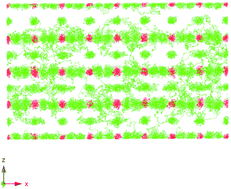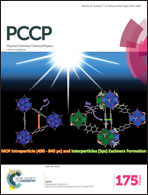Dimer-mediated cation diffusion in the stoichiometric ionic conductor Li3N†
Abstract
Non-equilibrium molecular dynamics has been used to model cation diffusion in stoichiometric Li3N over the temperature range 50 < T/K < 800. The resulting diffusion coefficients are in excellent agreement with the available experimental data. We present a detailed atomistic account of the diffusion process. Contrary to the conclusions drawn from previous studies, our calculations show that it is unnecessary to invoke the presence of a small concentration of intrinsic defects in order to initiate diffusion. The structure can be considered to consist of alternating layers of composition Li2N and Li. As the temperature increases an increasing number of cations leave the Li2N layers and migrate either to the interlayer space or to the Li layer. Those that move into the interlayer space form Li2 dimers with cations in the Li2N layers and those that move into the neighboring layer form dimers with cations therein. The two types of dimer are aligned parallel and perpendicular to [001], respectively and have lifetimes of ∼3 ps. The vacancies so created facilitate rapid diffusion in the Li2N layers and the interlayer cation motion results in slower diffusion perpendicular to the layers.


 Please wait while we load your content...
Please wait while we load your content...